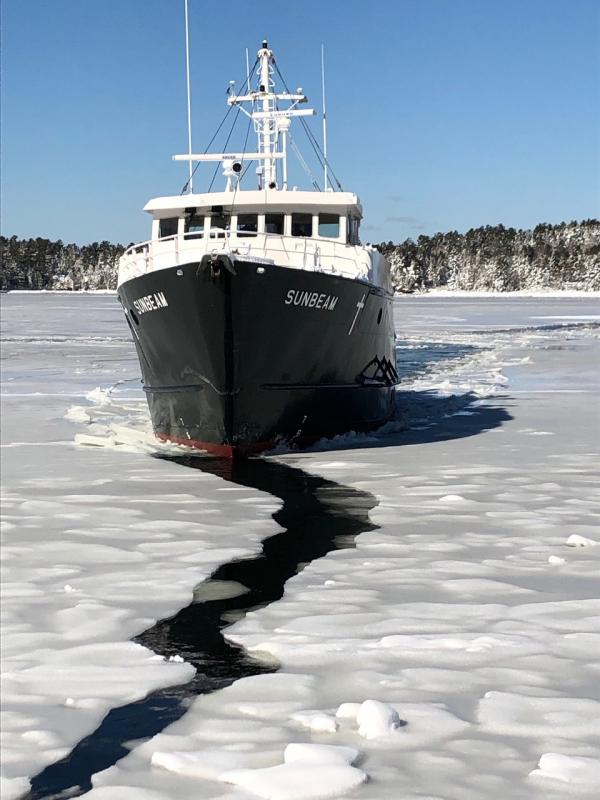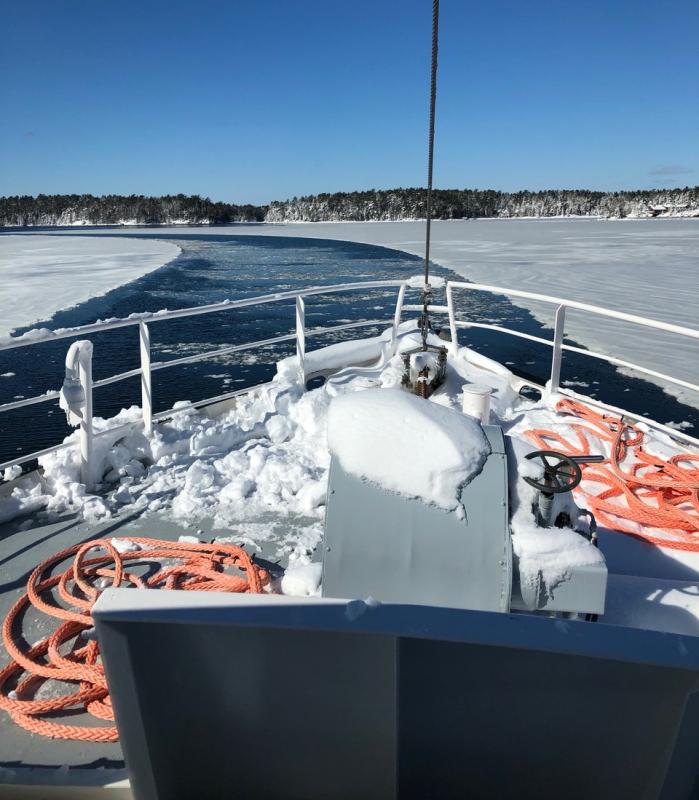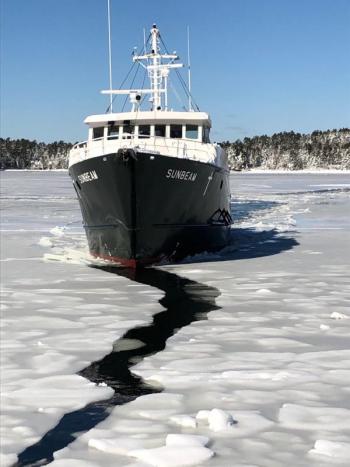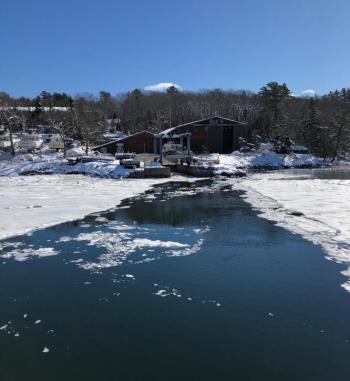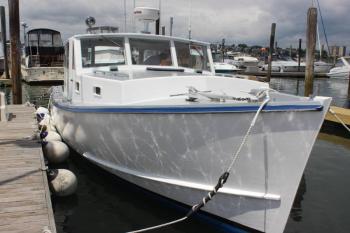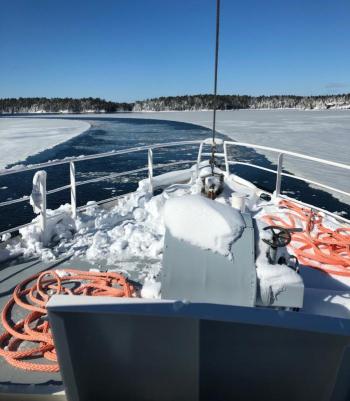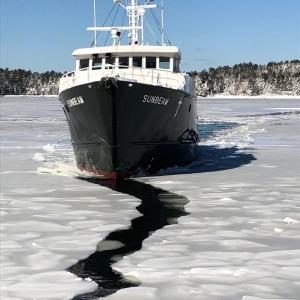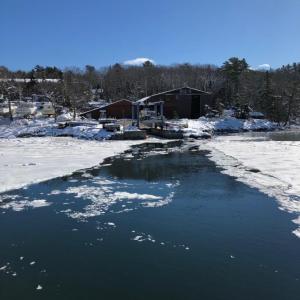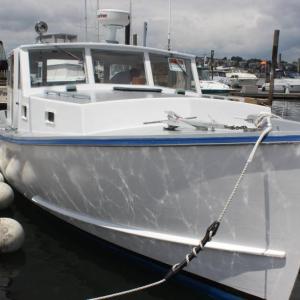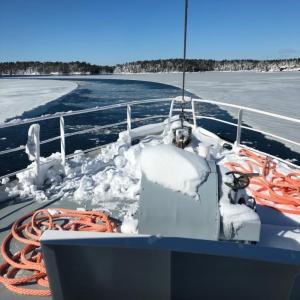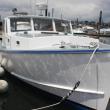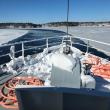Without an agenda: talking with the crew of the ‘Sunbeam’
Part 1: A discussion with the captain and the engineer about breaking ice, the needs of a steel boat, and the substitute mission vessel Moonbeam
For over a century the Maine Seacoast Mission Vessel Sunbeam—meaning the latest in a series of boats named Sunbeam—has visited Maine’s offshore island communities to provide a range of services.
The Seacoast Mission, a well-loved Maine nonprofit which does not proselytize, and keeps the religious aspect of its work to a “when requested” level, has a new president, as John Zavodny learns the ropes of his new position. Soon, they expect to have a new base of operations as the Mission downsizes out of the historic Bar Harbor mansion it has used as an office since 1972. Most noticeable to islanders, the Sunbeam--the big steel boat which carries telemedicine services and the always-welcoming galley—will get a new look as well, as the vessel will soon be hauled out for major maintenance and an extensive interior refit.
The needs of remote islanders have changed over time, and the help offered to communities by the Mission has changed with the times as well.
These days, there are no school-aged children on deep-sea light stations requiring math textbooks. There are fewer weddings, baptisms and funerals on the islands where “the boat minister” is an absolute requirement, and there are darned few crusty old islanders who have never been to the mainland but who want a dentist delivered to them. There is less isolation, perhaps, but that doesn’t mean there is none.
I spoke with Captain Mike Johnson, engineer Storey King, steward Jillian (that is her full name) and registered nurse Sharon Daley earlier this month during one of the Sunbeam’s regular visits to Matinicus Island. (Chaplain Douglas Cornman was busy elsewhere when I interviewed the crew.)
After a recent segment filmed aboard the Sunbeam for British television and hosted by “Doc Martin” star Martin Clunes, and a steady stream of articles by many other journalists including Kit Seelye, the New England Bureau Chief of the New York Times, I was worried that my friends on the crew would be tired of explaining what it is they do. Instead, they were gracious and patient as they indulged yet another round of questions over coffee and Jillian’s excellent blueberry pie.
For the most part I wanted to avoid getting too abstract and sentimental about how the Sunbeam--and the Seacoast Mission in general — serve the offshore and downeast communities of Maine. I meant to stick with nuts-and-bolts topics, although when talking about the Sunbeam that may be easier said than done. But Jillian, while describing the sense of community bonding and reassurance sometimes resulting from a simple shared meal, mentioned that the real friendship came “without an agenda.”
The Sunbeam’s home port is Northeast Harbor, and many of the present and former crewmembers have been from the Mt. Desert Island area. Captain Mike Johnson grew up in Seal Harbor and went to the University of Maine at Orono. “I mostly learned my seamanship from my father, who was an offshore sailboat captain.” Mike started aboard the Sunbeam as engineer in 2001, under Captain David Allen, and became the captain in 2008 when Dave retired.
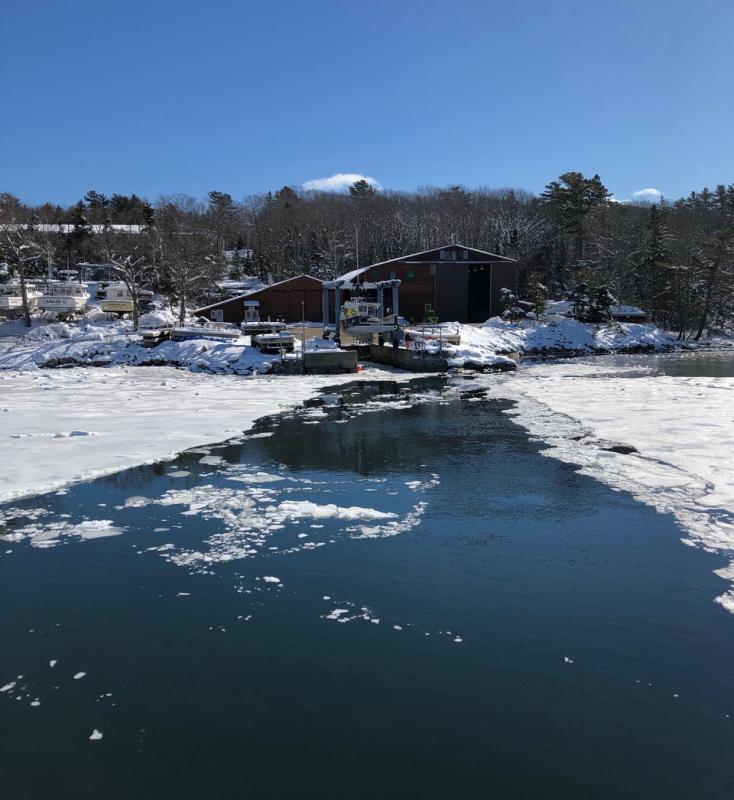
Mike describes his vessel as you might any work boat: “The Sunbeam is a 74’ trawler-designed boat. The architect who designed it, John Gilbert from Boston, primarily designed offshore fishing boats so we’ve got a robust, seaworthy vessel that can get us out to Matinicus in adverse winter conditions. She was built at Washburn and Doughty in East Boothbay and launched in 1995. She’s powered right now with a 454 HP Caterpillar, and there are 2 auxiliary generators to provide domestic power such as Jillian’s galley, navigation equipment, etc. We plug in on some of the islands (Matinicus Plantation Electric Company provides shore power for the Sunbeam). The boat cruises at about 9 ½ knots, so no, she’s not built for speed!” Mike grins at Jillian the cook and adds that, “We have to come (down from the wheelhouse and) get a cup of coffee and piece of blueberry pie to sustain us during the long passages.”
Mike explains the “refit” that is scheduled to take up much of 2019. “We’re on a very strict exterior maintenance schedule. She goes in every year for an exterior paint job, so the outside of the boat looks pristine, but what happens with a steel boat is that below-deck areas, which we can’t access, start to rust from the inside out. We’ll rip out the downstairs level--all the wooden structure will be gutted, the state rooms, the laundry--and we’ll have full access to the metal, which will be sandblasted. The whole interior of the hull will be inspected, all corrosion removed, and get painted. They’ll do any plate replacement which may be needed, although I don’t anticipate any. That’s such a big job that it’s the perfect opportunity to do cosmetic work. The interior is getting a little dated, so while the boat’s ripped apart we’ll put in new flooring, paneling, windows, new appliances, and new marine electronics. We’ll upgrade most everything and get it ready for another 20 years of service.”
“The main engine is the only significant piece of equipment that’s been replaced on the boat since she was new. That doesn’t have a high number of hours, so we don’t need a new engine, but the two generators will be replaced with more fuel-efficient, quieter models. Sharon’s clinic room has already been renovated, so that’s only having some minimal work, but most of the boat will be updated.”
I asked Mike how long he thought the ‘Beam would be out of service. “We’ve arbitrarily thrown out a timeline of six months. Some of the shipyards who are bidding on the project say that’s reasonable, others say that’s too short. Requests for bids have been sent to five Maine yards. Being a Maine organization that serves Maine folks, the Seacoast Mission thought it would be the wrong message (to hire an out of state yard if we didn’t have to) so we exclusively asked Maine shipyards.”
As of the interview the winning bid had not yet been determined, but Mike indicated it would be very soon.
The crew also explained that raising the needed funds for such an extensive refit went surprisingly quickly, with many generous donors helping to make the project possible. “We had a short and sweet fundraising campaign, and raised a lot of money quickly. It was roughly 50-50 between small private donations, largely from Maine, and several foundation grants.”
One very real-world, unsentimental way the Sunbeam can sometimes help is that the boat was built rugged enough to serve as a small icebreaker. Mike was happy to talk about that job.
“We hadn’t done any icebreaking in two or three winters, and then I got a phone call at about 6:00 a.m. the other morning from the Henry R. Abel Company up in Somes Sound. We’d had a big rain event and that fresh water sits on the surface of the salt water and freezes very fast, so they couldn’t launch a boat. There was a fisherman who was chomping at the bit to get out of there. Henry R. Abel called, then the fisherman who had to get out called, then Henry R. Abel called again. Storey wasn’t available to go that day because he had his captain’s license physical scheduled so he wasn’t home, so they sent a helper up. It wasn’t an extensive icebreaking operation but we punched a hole in front of the TraveLift, and they got the fisherman out.”
“(Previous Sunbeam captain) David (Allen) designed the hull and keel thickness, and they are made for icebreaking, and also for resting on the bottom at Matinicus.”
When the Sunbeam makes its regular, bimonthly overnight visit to Matinicus to provide telemedicine services, the boat must ground out beside the wharf. Coming and going is dependent upon the tide.
Mike talked about icebreaking during a recent severe winter. “Isle au Haut shut in really bad in --I think it was-- 2015. We had to make multiple trips down there; it just wouldn’t give up. Four or five times we had to go through that thoroughfare. That was probably the most critical icebreaking we’ve done. A lobsterman theoretically could wait, but the ferry (the Isle au Haut mailboat) had to get to Isle au Haut!”
“It’s sort of “controlled community service.” We certainly can’t go break ice for anybody and everybody who calls, it has to be close, within our usual service area. We can’t go to Eastport! We’re just too slow. We got a call from someone in like Gouldsboro Bay or somewhere, and I had to apologize.”
“David (Allen) broke a lot of ice with this boat. There just hasn’t been the ice recently. In 2015 I had to call David when we were headed up Somes Sound. It was thick ice, so I called David and said, ‘You’ve done a lot more icebreaking than I have. Why don’t you come along?’ He deserves a lot of respect. I have so much respect for his knowledge. I didn’t realize some of the nuances of it. For example, if you lose the ability to turn, you have exceeded the capacity of the boat. You can go straight through the ice, but if you turn the rudder and the boat can’t turn, you’ve got yourself in a bad situation. At that point you’d have to back out, and sometimes the ice will break off and close in behind you.”
Mike joked, “We’d have a happy little winter stuck in the middle of Somes Sound! But Dave Allen knew what he was doing. At one point David said, “We’ve got out get out of here.”
Sunbeam engineer Storey King grew up in Southwest Harbor, went to Maine Maritime Academy, and spent his childhood on the waterfront. “I’ve been hanging around boat forever,” He says. Storey joined the crew as engineer when Mike took over as captain from David Allen, but he is also a licensed captain. I asked Storey about the little boat that the Mission is buying to substitute for the Sunbeam during the lengthy haul-out this year.
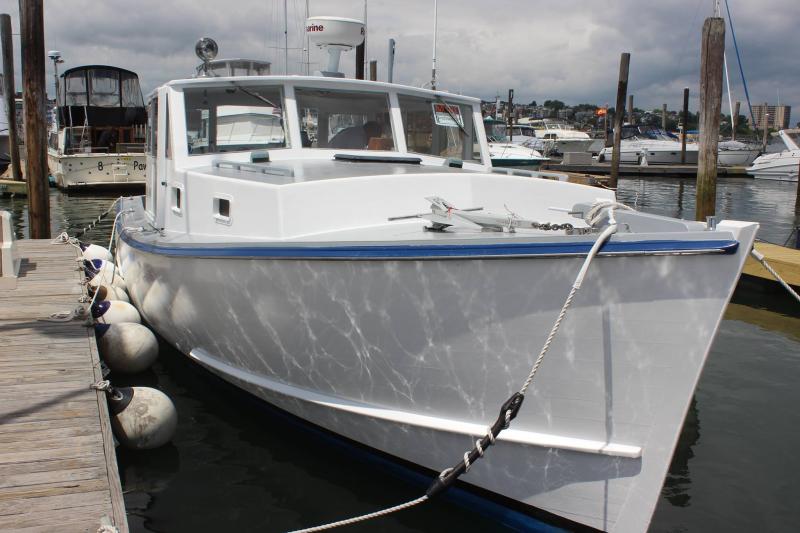
“It’s official now--the new boat will be called the “Moonbeam.” (That the name was chosen by island schoolchildren.) She’s a 34’ wooden boat built in Portland in 1990, built as a pleasure boat with an extended cabin, but with a lobster boat hull design. She’s powered by a caterpillar 3208 and does 15 knots top speed. It’ll be day-use only, there are no bunks, and we can’t take large groups around. The primary use of the vessel will be to get Douglas (the chaplain) and Sharon (the nurse) to the closer islands of eastern Penobscot Bay—the Cranberry Isles, Frenchboro, Isle au Haut—so they can continue with their duties to the communities. We’re mainly just transportation.”
Storey King will serve as the regular captain of the Moonbeam.
The Moonbeam is a bit small for the long trip to Matinicus, where sea conditions are frequently challenging, particularly during the winter, and there is nowhere to tie up alongside a wharf at low tide. Because Matinicus does have an airstrip Douglas and Sharon will be flying to that island on a regular basis to see patients and others. “If it’s a beautiful day we may take a run out,” said Storey, “but Matinicus can’t be part of its regular route.” I assured him that we’d love to see the little boat when conditions permitted.

A photo of the soon-to-be Moonbeam showed her name as “Pumgustic.” Storey explained, “That’s the old name for the reversing falls up the Royal River in Yarmouth.”
Storey had the job of locating the boat to be the short-term substituted for the Sunbeam. “I went down and looked it over, thought it should do well. We had Rick Savage from Northeast Harbor (R.M. Savage and Sons) survey it, it did fine on the survey, so we’ll just be making a few minor modifications.”
Then Storey smiled and looked at his watch: the real world and his job as ship’s engineer called. “Anything else real quick? I’ve got to climb under the boat, see if there’s anything in the wheel, check the zincs, see if any of them need to be replaced. This is the only place where we’re out of the water regularly.”
Next time: Part 2-- Talking with nurse Sharon and steward Jillian about “truck calls,” the opiate crisis, August as the cruelest month, and the joys of eating together.
Event Date
Address
United States

